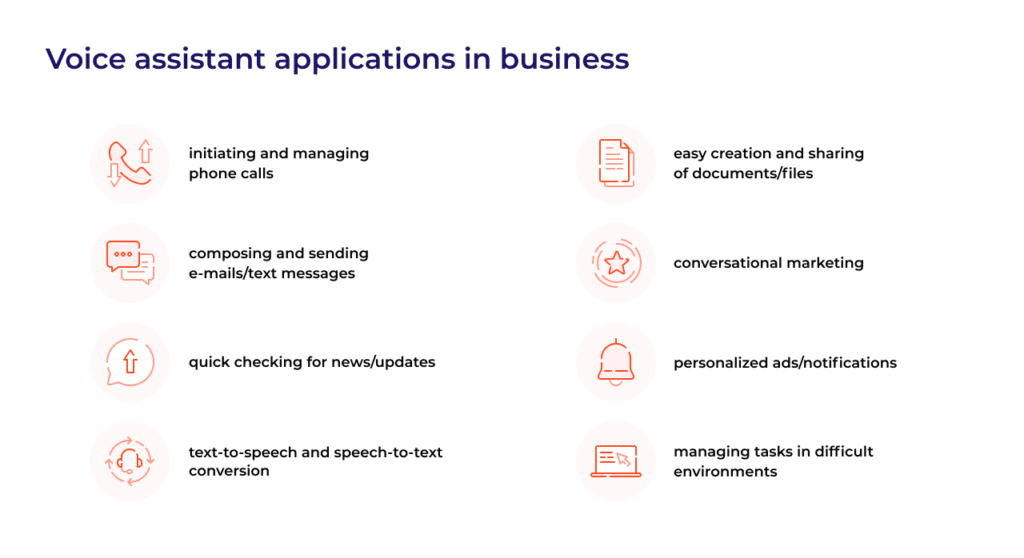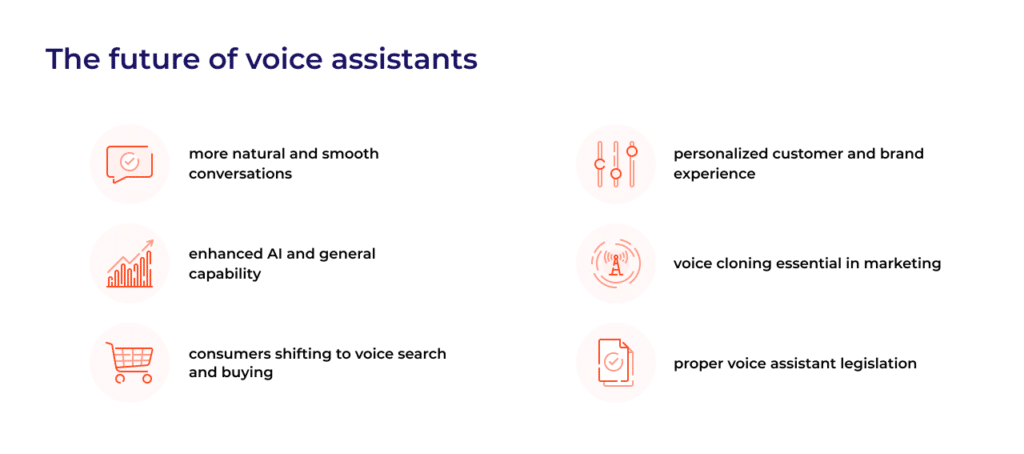OK Google, how will future voice assistants aid my work?

Voice assistants are changing how we manage our work and home tasks – we can perform them quickly and easily thanks to voice technology. These digital assistants have been with us for almost a decade, but the way to smooth communication with a bot is still long. We are developing better voice recognition software and algorithms, so the possibilities of using voice assistants in business keep growing. Although there are security issues to be resolved, the voice tech market attracts many different sectors. Here, you can learn crucial concepts related to voice assistants and discover their future business applications. Are you ready to start? “Alexa, launch our rocket!”
What is a voice assistant?
Smartsheet defines a voice assistant as a digital assistant that can understand our speech through voice recognition, natural language processing (NLP), and machine learning. Then, it can give us an answer using speech synthesis and/or perform a task for us. Voice assistants belong to a group of digital assistants, and the differences between them can be hazy. Among them, Smartsheet enumerates:
- Intelligent/Automated Personal Assistants – they can answer our questions through voice/text;
- Smart Assistants – separate electronic devices triggered by a wake word;
- Virtual Digital Assistants – applications or platforms that understand written/spoken language;
- Chatbots – software that can simulate a text conversation with a user, popular in preliminary customer service and AI-based chatbot marketing.
Another division is based on the digital assistant inner core. Frederik Goossens divides them into rule-based bots (their core is built around scripted dialog flows – their response capacity is limited) and AI assistants (they use deep learning for natural language processing to successfully manage a conversation). A good example of the latter is when the Google Duplex AI assistant calls a local business to ask for a haircut appointment.
As you could hear, the voice assistant understands speech, and thus can successfully carry out its task. You might also agree that you’d rather say what’s on your mind than type it down, especially when you are busy with something else. So the bottom line is that voice assistants were developed as a result of our needs. But when did it start?
“Hey Siri, show me the timeline!”
This year, we are celebrating Siri’s 10th birthday. Apple’s voice assistant was the first one in our history. Its default wake words “Hey Siri!” and unique voice provided by Susan Bennett are now iconic. Other ones followed shortly after. FoWB provides a timeline for the best voice assistants (in terms of popularity):
- Siri by Apple – a smartphone-based voice assistant app (2011);
- Alexa by Amazon – in 2014, Amazon released the Amazon Echo Smart Speaker, the first household appliance containing Alexa, Amazon’s voice assistant;
- Google Assistant – launched in 2016 as a smartphone and smart device-based (and thus a more versatile) intelligent personal assistant.
The voice assistants list also includes other examples: Cortana by Microsoft (2014), or the latest Samsung Sam voice assistant (2021). Some of them didn’t survive: Google Now (2012-2016), M by Facebook (2015-2018), or Bixby by Samsung (2017-2020). Most assistants are still being developed to fulfill more complicated tasks. This raises a question: How popular are they?
“Alexa, how popular are voice assistants?”
The popularity of voice assistants is on the rise. A survey by PWC from 2018 shows that:
- 65% of people aged 25-49 use voice assistants at least once a day;
- most respondents use their smart speakers while cooking (65%), multitasking (62%), and watching TV (57%);
- voice assistants are mostly used for checking the weather/news (35%), playing music (33%), and searching for things normally looked up online (32%);
- 34% have purchased ready-made food at least once through a voice assistant;
- 44% use voice assistants to control other smart devices – mostly TVs (58%).
As you can see, voice assistants are becoming a part of our daily lives. But the most shocking are the findings by Statista – the number of voice assistants in use will reach 8.4 billion by 2024, exceeding the human population. How is that? The growing opportunities in the Internet of Things (IoT) mean that we might use multiple assistants to manage many appliances and tasks. For instance, you can use Google Home to control all voice assistant-related devices around your house and also use Siri to deal with your smartphone-related tasks.
“Hey Google, what can you do?”
It might be reasonable to use several assistants at once as they come with different devices and have various uses. Apart from the above, voice assistants can:
- initiate and manage phone calls;
- send e-mails or text messages;
- check current conditions in many places around the world, e.g. road traffic/flights;
- convert text to speech (reading aloud) and speech to text (transcription).
It’s evident that intelligent virtual assistants can do quite a lot without engaging you manually. That’s why they also offer many business applications. What are they exactly? Let’s go through specific business divisions.
Voice assistants in workplaces
A lot of office work nowadays involves using computers. However, shifting between the keyboard and other places can be time-consuming. Not to mention situations when you have to manually click through software or platforms to find what you need. Voice recognition software can help you with:
- easy information sharing;
- taking notes and creating documents;
- setting up meetings or reporting.
Completing these tasks hands-free allows you to perform other activities without breaking your work pace. You can concentrate on your current task and, as a result, become more efficient while saving time.
These reasons prove that voice assistants will excel in sectors where free hands are needed all the time. Think about scientific facilities where people need to wear protective gear and can’t use standard buttons or keypads. Intelligent virtual assistants will be an empowering aid in their jobs.
Another sector that will massively adopt voice assistants is research companies. Advanced natural language processing and machine learning will allow their employees to find documents and compile reports much faster and without all the frustration with misplaced files.
Voice assistants in e-commerce
Buying online via voice assistant apps or devices is not sci-fi – it’s already happening. People don’t dare to buy more complex things yet. However, the developments in this area may soon impact their attitudes. The market is already observing certain consumer search behavior changes. Customers will always choose the simplest way to do things, so voice buying seems a natural process to be adopted.
Capgemini’s survey shows that 76% of organizations have recorded financial benefits from investing in voice assistants. Companies have already started the race to create the best virtual voice technologies to serve them. For instance, Amazon Alexa can help you buy products from certain brands thanks to Alexa Skills (specific voice assistant functions). And you don’t even need coding to create them – here’s how.
The evolution of deep learning for natural language processing will make voice assistants better at understanding our words and responding more adequately. This will cause a shift in consumer search behaviors. Companies will eventually have to incorporate appropriate voice search strategies to keep up. Unite.ai predicts that the value of shopping via voice assistants will reach USD 40 billion in 2022. The area of voice shopping trends is worth exploring.
Voice assistants in marketing
Introducing voice assistants into marketing uncovers an entire galaxy of opportunities. First of all, they allow for conducting successful conversational marketing – the type of marketing focused on individual customers and creating dialogue in real-time. Intelligent personal assistants can remove the burden of carrying these conversations from regular employees. Future voice assistants will provide more personalized experiences and streamlined conversations. As a result, you will have a casual chat with an intelligent virtual assistant that will provide relevant information on products or companies.
Another important aspect of voice marketing is voice advertising. We already have many ads around us, and consumers hate the idea of getting more via smart assistants. However, PWC’s survey provides optimistic results:
- 71% of respondents would like the ads if they were directly tied to their current queries;
- 73% would prefer personalized ads based on their previous queries;
- 70% would appreciate the possibility of interacting with the ads;
- 70% wouldn’t mind the ads if they were related to their favorite brands.
The situation of voice ads isn’t that dire after all. Marketers just need to find a way to make them non-invasive and well-thought. And speaking of optimism, Voicebot.ai claims that the majority of marketers are optimistic about both voice search marketing of products and voice commerce. So, it’s very likely that marketers will spend time and money on developing more elaborate voice marketing strategies.
Voice assistant ads can have more subtle forms – push notifications. What are push notifications in terms of artificial intelligence personal assistants? These are reminders related to our calendar and work. You can use them for upselling and cross-selling based on your customers’ schedules to create a unique customer experience. For example, they can get a reminder about their spouses’ birthday with a tailor-made idea for a present. It’s only logical for marketers to reach out to their customers who need their products the most. This will bring voice search marketing to a whole new level.
Voice assistants in governmental institutions
The versatility of voice assistants has caught the eye of governmental institutions as well. Govtech describes how 7 state/local US governments use Amazon Alexa to interact with citizens and improve their work. Intelligent virtual assistants also have a positive impact on health care. They allow doctors and patients to stay in touch. It is critical during the pandemic as face-to-face contact isn’t the best option.
Voice assistants vs. security
The emergence of intelligent assistants also raised many controversies around the subject of security and privacy. According to Microsoft’s survey, 41% of respondents are concerned about their data security. Voice recognition technology providers have already taken precautions to prevent any data leaks. For instance, Google and Amazon have introduced speaker ID and verification.
The case remains open as voice assistants lack proper legal regulations. People sometimes don’t know what happens to their data. That is why businesses will have to undertake certain measures to ensure the safety of information provided to voice assistants. They will also need to update the users about their rights. The legislation of artificial intelligence personal assistants will probably be one of the most frequently considered technological issues in the upcoming years.
The last point regarding voice assistant safety is a feature described as voice cloning. Thanks to NLP machine learning, voice assistants can replicate an individual’s voice. Voice cloning will become an essential tool for content creators, but it can also threaten all forms of voice verification. BBC points out that cyber-criminals are interested in voice cloning. Why? View the video and find out how worryingly efficient real-time voice cloning software is. Then think what it might do in the wrong hands… This supports the idea that the advancement in virtual voice technologies should be followed by adequate laws to ensure public safety.
The future belongs to voice search
Despite the existing concerns about perfection or safety, voice assistants are becoming increasingly popular. They still have a long way to go, but they seem to be a major convenience in our rapid world. Businesses are already aware of the possibilities offered by virtual assistants in terms of building B2C and B2B relationships. As new tools are evolving, businesses need to understand the changes in customer behaviors and create new successful voice strategies. Even governmental institutions are benefiting from the use of intelligent personal assistants. So the best course of action is to monitor the customers, constantly develop voice recognition technology and make sure it’s secure. Set your course for the planet of voice assistants because behind every “OK Google!”, “Hey Siri!” and “Alexa!” there might be a lucrative business opportunity.
We hope that voice assistants will eventually make your work easier and generate revenue for your business. If you are interested in other advanced solutions, check our website or read more:





